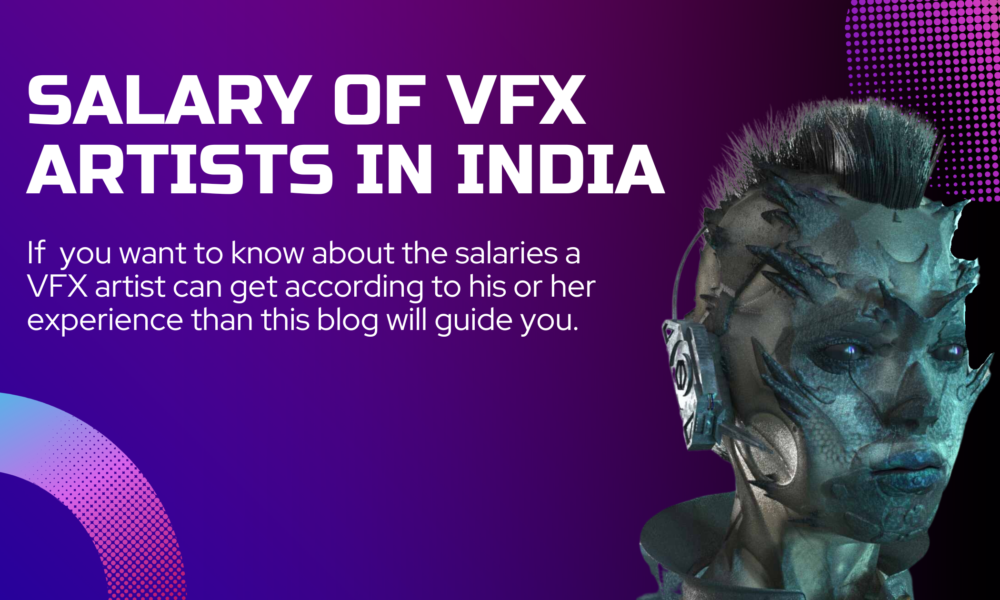
Before getting into the salary part you better know which skills are crucial for you to get a good job in the field of VFX. It’s a highly creative & skill-based field, so you must align your skills according to the industry standards. Before we deep diving into the the salary part lets understand what is VFX
What is VFX:
VFX stands for Visual Effects, which helps to create mindblowing movies, games, 3D animated movies, etc. but do we know what it takes to learn VFX it’s a gigantic term and it’s divided into many parts like Rotography, Texturing, Lighting Artist, VFX Editor etc.
Job roles in VFX field:
The world of visual effects (VFX) is a dynamic and multifaceted industry, and it takes a diverse team of professionals to create the stunning visuals we see in movies, TV shows, and commercials. Here’s a brief overview of some essential job roles in the VFX industry:
- Roto Artist: Roto artists are responsible for creating precise masks to isolate elements in a scene, allowing for the seamless integration of visual effects.
- Texture Artist: Texture artists breathe life into 3D models by adding textures and surface details, making objects and characters look realistic.
- VFX Coordinator: Coordinators play a crucial role in project management, facilitating communication between different teams and ensuring projects run smoothly.
- VFX Editor: VFX editors work on assembling visual effects shots into the final sequence, adjusting timing, and ensuring seamless integration with live-action footage.
- VFX Lighting Artist: Lighting artists create the ambiance and mood of a scene by adjusting lighting in virtual environments to match live-action elements.
- VFX Modeling Artist: Modelers build 3D assets such as characters, props, and environments, which serve as the foundation for VFX work.
- VFX Producer: Producers oversee project budgets, schedules, and team coordination, ensuring the successful delivery of VFX projects.
- VFX Supervisor: Supervisors lead VFX teams, making creative decisions, and ensuring the artistic and technical quality of visual effects work.
- Simulation Artist: Simulation artists specialize in creating realistic physical simulations, like water, fire, or explosions, to enhance visual effects sequences.
- Dynamic Artist: Dynamic artists focus on creating realistic movement and physics for objects and characters in VFX scenes.
- Look Dev Artist: Look dev artists are responsible for establishing the visual style and appearance of 3D assets, ensuring they match the project’s requirements.
- 3D Generalist: 3D generalists possess a broad skill set, working on various aspects of VFX production, from modeling to lighting.
- 3D Texturing Artist: Texturing artists specialize in creating intricate surface details and textures that bring 3D models to life.
- Rendering Artist: Rendering artists optimize and execute the final rendering of visual effects shots, ensuring they meet the project’s technical and artistic standards.
Required Skills:
- Strong Technical Proficiency: Mastery of industry-standard software and tools such as Adobe After Effects, Autodesk Maya, Nuke, Houdini, and others is fundamental. Knowledge of programming and scripting languages like Python can also be valuable.
- Uunderstanding of Cinematography: A solid grasp of camera work, lighting, and composition is crucial for seamlessly integrating VFX into live-action footage.
- 3D Modeling and Animation: Proficiency in 3D modeling, texturing, rigging, and animation is vital, especially for character and creature creation.
- Compositing: The ability to combine various visual elements into a cohesive final image is essential. Skills in green screen keying, rotoscoping, and tracking are critical.
- Problem-Solving: VFX often involves solving complex technical challenges creatively. Being able to troubleshoot and devise innovative solutions is essential.
- Artistic Eye: A keen sense of aesthetics, color theory, and visual storytelling is crucial for creating visually compelling effects that blend seamlessly with the narrative.
- Attention to Detail: Precision is key, as even the smallest mistakes can be noticeable in the final product.
- Communication and Collaboration: Effective communication and teamwork are essential, as VFX artists often work closely with directors, cinematographers, and other professionals in the industry.
- Time Management: Meeting tight deadlines is common in VFX production, so being able to manage your time and work efficiently is crucial.
- Continuous Learning: The VFX industry evolves rapidly. A commitment to ongoing learning and staying up-to-date with the latest tools and techniques is vital.
- Portfolio Development: Portfolio development is of paramount importance for VFX artists. In a highly competitive industry, a well-crafted portfolio serves as a visual resume, showcasing an artist’s skills, creativity, and versatility.
It provides potential employers or clients with a comprehensive view of an artist’s capabilities, enabling them to make informed decisions about collaborations or hiring.
A strong portfolio not only highlights an artist’s technical expertise but also their artistic vision and storytelling abilities.
It is a testament to their dedication to continuous improvement and staying up-to-date with evolving VFX technologies and trends. Ultimately, a compelling portfolio opens doors to exciting projects, career opportunities, and recognition within the VFX community, solidifying its significance in the professional journey of a VFX artist.
- Adaptability: The ability to adapt to different project requirements, styles, and client preferences is valuable in the diverse world of VFX. These skills, combined with a passion for visual storytelling and a dedication to honing your craft, can help you thrive as a VFX artist in this dynamic and competitive industry.
Salaries Based on Indian Cities:
Introduction: The world of visual effects (VFX) in India has witnessed remarkable growth in recent years, thanks to increasing demand for high-quality VFX in Bollywood, regional cinema, advertising, and the gaming industry. As a result, VFX artists are in high demand, and their salaries vary significantly based on experience and location within India. In this blog, we’ll explore how VFX artist salaries differ across the top Indian cities, taking into account varying levels of experience.
1. Mumbai: The VFX Hub:
- Junior VFX Artists (0-2 years): Salaries typically range from ₹2.5 lakhs to ₹5 lakhs per annum.
- Mid-Level VFX Artists (2-5 years): Earnings can vary between ₹5 lakhs to ₹10 lakhs per annum.
- Senior VFX Artists (5+ years): Experienced artists often command salaries exceeding ₹15 lakhs per annum.
2. Bengaluru: The Silicon Valley of India:
- Junior VFX Artists (0-2 years): Salaries start at around ₹2 lakhs and can go up to ₹4 lakhs per annum.
- Mid-Level VFX Artists (2-5 years): Earnings range from ₹4 lakhs to ₹8 lakhs per annum.
- Senior VFX Artists (5+ years): Experienced professionals can earn above ₹12 lakhs per annum.
3. Chennai: The Southern VFX Hub:
- Junior VFX Artists (0-2 years): Salaries typically start around ₹2 lakhs and can reach ₹4 lakhs per annum.
- Mid-Level VFX Artists (2-5 years): Earnings may vary between ₹4 lakhs to ₹7 lakhs per annum.
- Senior VFX Artists (5+ years): Experienced artists can expect salaries exceeding ₹10 lakhs per annum.
4. Hyderabad: The Emerging VFX Destination:
- Junior VFX Artists (0-2 years): Salaries usually begin around ₹2 lakhs and can go up to ₹4 lakhs per annum.
- Mid-Level VFX Artists (2-5 years): Earnings range from ₹4 lakhs to ₹8 lakhs per annum.
- Senior VFX Artists (5+ years): Experienced professionals can earn above ₹12 lakhs per annum.
5. Pune: Growing VFX Opportunities:
- Junior VFX Artists (0-2 years): Salaries generally start around ₹2 lakhs and may reach ₹4 lakhs per annum.
- Mid-Level VFX Artists (2-5 years): Earnings can vary between ₹4 lakhs to ₹7 lakhs per annum.
- Senior VFX Artists (5+ years): Experienced artists often command salaries exceeding ₹10 lakhs per annum.
6. Kolkata: The Rising VFX Scene:
- Junior VFX Artists (0-2 years): Salaries typically start at ₹1.5 lakhs and can go up to ₹3 lakhs per annum.
- Mid-Level VFX Artists (2-5 years): Earnings may range from ₹3 lakhs to ₹6 lakhs per annum.
- Senior VFX Artists (5+ years): Experienced professionals can earn around ₹8 lakhs or more per annum.
Conclusion: The salary of a VFX artist in India is influenced by factors such as experience, skills, and location. While Mumbai remains the hub for VFX, other cities like Bengaluru, Chennai, Hyderabad, Pune, and Kolkata are catching up, offering competitive salaries and exciting opportunities. As the demand for VFX continues to rise in India’s entertainment and advertising sectors, VFX artists can look forward to promising career prospects with salaries that correspond to their experience and expertise.

